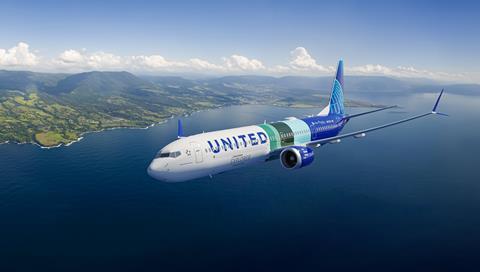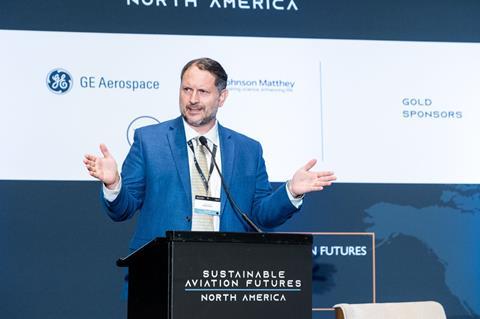
Sustainable Aviation Fuel (SAF) is already known to reduce carbon emissions by up to 85% over the fuel’s life cycle. Certain types of SAF also produce less soot than conventional jet fuel and therefore could help affect contrails, which form in cold, humid air.
New flight tests announced by Boeing as part of its ecoDemonstrator Explorer program, in collaboration with GE Aerospace, NASA, United Airlines, and others, aims to determine to what extent SAF can impact the characteristics of persistent contrails.
Boeing’s second ecoDemonstrator Explorer, a 737-10 destined for United Airlines, will fly with 100% SAF and conventional jet fuel in separate tanks and alternate fuels during testing. NASA’s DC-8 Airborne Science Lab will fly behind the commercial jet and measure emissions produced by each type of fuel and contrail ice particles. NASA satellites will capture images of contrail formation as part of the testing.
The researchers aim to understand how advanced fuels, engine combustor designs and other technologies may reduce atmospheric warming. For example, tests will assess how SAF affects the characteristics of contrails, the persistent condensation trails produced when airplanes fly through cold, humid air. While their full impact is not yet understood, some research has suggested certain contrails can trap heat in the atmosphere.
Expert: SAF is here to stay
The Boeing ecoDemonstrator Explorer program is one example of collaboration across the aviation industry to reach a more sustainable aerospace future. SAF offers the largest potential to reduce carbon emissions in the industry over the next 30 years or so, and it’s here to stay, said Gurhan Andac, GE Aerospace’s engineering fuels and fuel additives leader.
Today, SAF production is about 0.1% of jet fuel consumed worldwide. At the recent Sustainable Aviation Futures North America Congress in Houston, Texas, discussion was driven by the financial, feedstock, logistical, and other barriers to overcome to send SAF production and availability higher … much higher.
Despite the current low volumes, Andac points out that SAF is here to stay.
Earlier this year, standards-setting organization ASTM International approved an eighth way to make SAF blended with conventional jet fuel, with more production process pathways in review. Additionally, ground and flight tests have taken place globally to inform efforts underway for development of a new standard for 100% or unblended SAF.
GE Aerospace has been involved with SAF for more than 15 years, since efforts to test synthetic fuel began, Andac explained. All GE Aerospace engines can operate with approved SAF blends today. That’s because approved SAF blends are drop-in, meeting specifications of Jet A and Jet A-1 and requiring no modifications to aircraft and engine equipment or infrastructure to use it.
“SAF is not an R&D project we conduct on the side. It’s in the field. We have over half a million flights in the aviation industry. Granted, these are at very low volumes, but it’s out there and we’re flying,” Andac said.

GE Aerospace’s long history of SAF testing in collaboration with industry partners includes the first commercial demonstration flight of biofuel in 2008, the first commercial aircraft flight with 100% SAF in 2018, SAF engine emissions testing, and the first passenger experimental flight in 2021 with 100% SAF in one of the two engines.
“We’ve been very active,” Andac said.
Interplay of fuels and propulsion technologies
GE Aerospace is also developing new aircraft engine technologies that are more fuel efficient than today’s engines. CFM International, a 50-50 joint company between GE and Safran Aircraft Engines, is progressing on its Revolutionary Innovation for Sustainable Engines (RISE) program, the most comprehensive suite of technology development in company history with more than 1,000 GE and Safran engineers working the program worldwide.
“The CFM RISE program—this is really our answer for the next generation of technologies,” said Jeff Shaknaitis, GE Aerospace customer sustainability leader, who also spoke at the October Sustainable Aviation Futures North America event.
“There’s really a couple of key markers,” Shaknaitis said. “Keep delivering more efficient propulsion technologies, helping reduce the primary energy demand from aviation. Second is making sure we’re accessing the right energy vectors that are going to be available to us, recognizing we don’t have control over the energy transition.”
Open fan engine architecture, hybrid electric systems and other technologies being matured as part of the RISE program are being designed to be compatible with existing jet fuels and 100% SAF.
“We want to make sure we have technologies that are flexible to adapt over time,” Shaknaitis said.



























